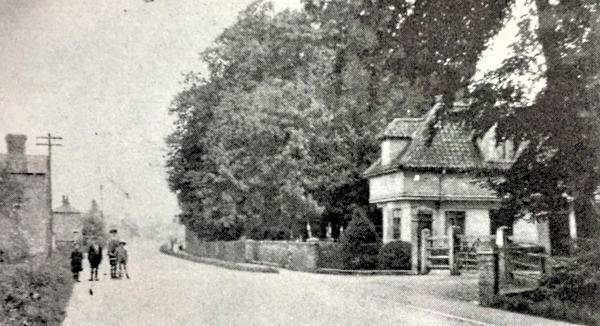Gosberton was always a progressive village and was in the forefront of moves to bring improved standards of living to it’s inhabitants.
We know that gas was first introduced into the village in 1871. The local newspapers for that year seem to have been lost but I have examined the plans for the buildings that are now in Lincolnshire Archives and so have gained a picture of the scale of the works. The plans were drawn by Sherwins of Boston.
The picture below shows the Lodge at the entrance to Gosberton House park, and on the left near to where the children are standing, one can see the front of the house occupied by the Gas Works manager. The works themselves were to the side and behind the house and nothing now remains.
 The supply of gas seems to have been somewhat unreliable and the Press of the day often records periods of days and weeks when no gas was available. It is not surprising that the locals did not rush to avail themselves of this ‘modern’ convenience.
The supply of gas seems to have been somewhat unreliable and the Press of the day often records periods of days and weeks when no gas was available. It is not surprising that the locals did not rush to avail themselves of this ‘modern’ convenience.
In 1894 the shareholders meeting discussed yet another deficit in the accounts of £11.0.0 and expressed their concern that villagers did not appreciate the benefits of having a gas supply. Consideration was given to letting the works.
Quite clearly things must have improved as it was not until 1914 that efforts were made to install gas lighting into the Church. This work was put out to tender and was undertaken by a Sheffield firm who offered to do the work for the sum of £35.16.6.
I have no idea when the supply of gas came to an end in the village. The works were certainly still there when I was a child in the 1930/40s.



2 Responses
Fascinating little item.
Given that the recorders I know of, give Gosberton Railway Station not opening until 1882 and the works providing gas in 1871.
Do you know how and from where the Gas Works obtained its Coal?
The only possibility I can think of is that it was by water, then local cart from:
The port at Donington on the BSN or via the Risegate Eau, into Gosberton.
Not certain when the Gowt lock collapse into the Welland?
I would also be most grateful to know of any photos of working craft on the BSN before the 1960’s.
Thanking you in anticipation.
Thank you for your thoughts for which I don’t have an answer. I have a number projects ongoing and the navigation and transportation from the ports inland is planned. West Deeping had a canal https://wdheritage.wordpress.com/boaty-story/
The port of Spalding must of had a distribution system for heavy commodities like coal. The Romans created Car Dyke which was a navigation between Lincoln and Peterborough. I also believe water came from Bourne. https://www.heritagesouthholland.co.uk/article/the-supply-of-fresh-water-to-gosberton/
Very happy to work together on this.
Regards
Geoff